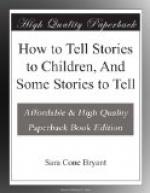“But how, at the end of a hard morning’s work, can I be interested in a story I have told twenty times before?” asks the kindergarten or primary teacher, not without reason.
There are two things to be said. The first is a reminder of the wisdom of choosing stories in which you originally have interest; and of having a store large enough to permit variety. The second applies to those inevitable times of weariness which attack the most interested and well-stocked story-teller. You are, perhaps, tired out physically. You have told a certain story till it seems as if a repetition of it must produce bodily effects dire to contemplate, yet that happens to be the very story you must tell. What can you do? I answer, “Make believe.” The device seems incongruous with the repeated warnings against pretence; but it is necessary, and it is wise. Pretend as hard as ever you can to be interested. And the result will be—before you know it—that you will be interested. That is the chief cause of the recommendation; it brings about the result it simulates. Make believe, as well as you know how, and the probability is that you will not even know when the transition from pretended to real interest comes.
And fortunately, the children never know the difference. They have not that psychological infallibility which is often attributed to them. They might, indeed, detect a pretence which continued through a whole tale; but that is so seldom necessary that it needs little consideration.
So then: enjoy your story; be interested in it,—if you possibly can; and if you cannot, pretend to be, till the very pretence brings about the virtue you have assumed.
There is much else which might be said and urged regarding the method of story-telling, even without encroaching on the domain of personal variations. A whole chapter might, for example, be devoted to voice and enunciation, and then leave the subject fertile. But voice and enunciation are after all merely single manifestations of degree and quality of culture, of taste, and of natural gift. No set rules can bring charm of voice and speech to a person whose feeling and habitual point of view are fundamentally wrong; the person whose habitual feeling and mental attitude are fundamentally right needs few or no rules. As the whole matter of story-telling is in the first instance an expression of the complex personal product, so will this feature of it vary in perfection according to the beauty and culture of the human mechanism manifesting it.




